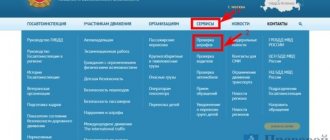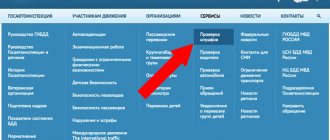A used car is always a “pig in a poke”. External well-groomed appearance and the presence of all documents do not mean anything: modern technologies make it possible to easily and quickly turn a neglected car with numerous defects into an attractive, marketable vehicle. As for documents, they are forged everywhere and en masse, and in many cases the fact of forgery can be recognized only through a complex examination.
Even when buying a car at a car dealership or autohouse, you cannot be completely sure that it:
- is legally clear;
- is not listed as stolen and is not wanted, for example, for participation in an accident;
- has no claims from customs, banking and insurance companies;
- is not under arrest or on bail;
- is not the subject of civil, judicial or other disputes;
- has no restrictions on use and alienation, as well as other encumbrances.
But currently it is possible to check a car for free using the PTS number on the traffic police website online. This service is a truly effective measure against fraud and dishonesty of sellers, and allows you to receive detailed and up-to-date information about the vehicle of interest in just a few minutes.
What is PTS and why is it needed?
A vehicle passport is a document that stores all the basic data on the vehicle, sufficient for its unambiguous identification. These include the vin code, which consists of 17 characters and is indicated not only in the title, but also on the car itself; depending on the model, it can be located on the frame, under the hood, under the windshield, etc. When buying a used car, first of all It is the VIN code that is verified.
In addition, the transport information passport indicates the make, model and color of the car, its license plate number, engine volume and number, vehicle weight, chassis number, and production date.
Before checking a car using its PTS number in the traffic police database, you need to verify the authenticity of this document. To do this, pay attention to the following features.
- Passport ornament. This is a specific pattern that should not lose clarity upon closer examination.
- Hologram. It should also be easy to read and clear. Falsification of this information is the biggest problem for scammers.
- Volumetric drawing. It is located on the back of the document, made in the form of a kind of “rose” and can be detected by touch, and also changes its color under different viewing angles.
- Watermark. It is visible in the light and represents the inscription RUS.
A vehicle passport can be issued by the vehicle manufacturer or by organizations involved in converting vehicles into special equipment, by the traffic police or by the customs service. In the latter case, you should be especially vigilant if Lithuania or Belarus is indicated as the country of origin of the car. These countries have a well-developed business in restoring vehicles after serious road accidents, as well as in assembling cars from fragments of several different cars.
What does the prohibition of registration actions mean?
This action is common for use in the field of transport management, and represents a sanction for a motorist’s violation of the relevant legislation. The ban is related to the inability of the owner of the vehicle to dispose of it as his own.
It is in the nature of a temporary measure aimed, first of all, at eliminating the committed unlawful act. As an example, we can indicate the process of customs clearance of a vehicle brought from abroad that was not carried out according to the rules, or a banal non-payment of taxes. In relation to this procedure, it is possible to check the ban on vehicle registration.
What do you need to know about a copy of PTS?
You can check a car by PTS number online based on both the original and a copy of the document.
However, you should be careful when purchasing a car with a copy of the vehicle title. Using a duplicate is one of the most common schemes for selling problem cars. In particular, this is how credit cars are usually sold (since the original title in this case remains with the bank), as well as vehicles that are listed as stolen.
You can recognize a problematic credit car by a combination of the following signs:
- small age;
- low mileage;
- duplicate PTS;
- transit numbers.
Please be aware that a copy of the PTS has a structure and details identical to the original document (watermarks, three-dimensional image, etc.). The only difference is the presence of a “Duplicate” stamp in the special notes column.
As for legal cases of using a copy of a PTS, this usually occurs due to the loss of the original document, or when registration or personal data are changed. A duplicate is also issued if the vehicle passport runs out of fields intended for making entries about various registration actions. In this situation, the original document must be disposed of in the manner prescribed for such cases by current legislation.
How to remove the restriction
Advice! Initially, a person should remember to check the car for a registration ban. Errors in such cases are rare, and the decision is often justified, but in this matter you need to be attentive to all the details.
After the presence of the ban
became known to the person against whom it was applied, it is imperative to contact the MREO in order to obtain a copy of the notice, as well as other documents. The reason for the seizure of the car, which has become known, now requires elimination. According to the data indicated in the relevant decision, it is necessary to take active steps in the form of paying a tax payment or giving a legal form of registration to a transaction for crossing a car across the state border.
Once there is no longer a reason to seize the vehicle, you need to contact the authority that previously made such a decision with confirmation that the reasons behind it have been corrected. If everything is so, a document is issued on the basis of which the ban on registration actions in relation to the vehicle is terminated.
The final issue in this regard will be the submission of a new decision of the body or a court ruling to the MREO, which allows the car to be registered on the roads and removes the arrest, entering the relevant information into a unified information database.
Checking a car using PTS online
You can check your car using its title either in person at the State Traffic Inspectorate or via the Internet. The advantages of the latter option are obvious: the corresponding online services are available around the clock, the result is displayed immediately after sending the request (sometimes you have to wait a couple of minutes), the information is updated automatically. This check allows you to:
- obtain information about fines for traffic violations committed on this vehicle:
- check the information specified in the PTS;
- find out whether the car is under arrest and whether there are any restrictions on registration actions;
- check whether the car is listed as stolen;
- obtain information about road accidents committed on this car (if any).
Currently, there are several online services that allow you to quickly check a vehicle using its passport. But it is best to use the appropriate section of the traffic police website for this, since it contains the most complete, accurate and up-to-date information about vehicles. On other resources, database updates may occur with a certain delay.
How is a car checked?
When buying a new car, the owner receives a unique VIN number (located on the frame, body or other hard-to-reach place of the car), without which it is impossible to register. If the vehicle was used, the previous owner had already registered this code. Knowing the vehicle registration certificate number or VIN, the check can be carried out almost instantly. The database will help check the owner’s honesty: find out whether the car has been in an accident, whether it has material and procedural restrictions (fines, bail, confiscation decisions). Of course, similar information is provided to the traffic police upon application. But verification will take time (up to 30 days for a written request), so it is much easier to request information online. On the official website of the inspection you must:
- Select the “Online Services” section.
- Go to the “Vehicle Check” category.
The search for information begins after entering the VIN number and verification code - captcha. The number is contained in the papers on the vehicle (PTS, registration certificate). If you can’t find it, you can also enter the body or chassis number. The search takes no more than a minute. Violations in the process of selecting information are reflected on the monitor. In Moscow and the region, a similar system has been operating for a long time. But for the country, the database has become a source of reliable information about the necessary vehicle. It is worth noting its convenience, search speed, and the requirement to indicate only the individual vehicle number. For comparison, the Autocode service requests the registration certificate number, state registration number. To use this service, you must be a verified user of the government services portal.
Checking a car by PTS number on the traffic police website
You can check your car using its title on the traffic police website in just a few minutes. The process is carried out step by step, the service is provided free of charge, 24 hours a day, 7 days a week. Verification can be carried out based on the following data:
- vehicle chassis number;
- vehicle vin code;
- body number.
To perform the check, you need to go to the traffic police website at https://www.gibdd.ru. On the right side of the page there is a section “Online services of the traffic police” - in it you need to select the item “Vehicle check”.
Next, in the appropriate field, you need to enter the vehicle’s vin code or its body or chassis number, and then click on the “Request verification” link in the section that interests you at the moment.
After clicking the link, you will also be required to enter a verification code. After a minimum time, information about the results of the scan, including its date and time, will be displayed on the screen.
The check can be carried out repeatedly. Please note that the latest changes may not appear in the database immediately, but after a certain period of time. It is necessary to understand that scammers are trying to get rid of problem cars as quickly as possible - before they manage to get into the appropriate traffic police databases. Therefore, even if a car check according to the title shows that the vehicle is legally clean, does not have any restrictions on use/alienation, as well as claims from the traffic police and other authorities, it is recommended to carry it out again after a certain time.
In any case, it is advisable to begin re-registration of the car in the presence of its current owner.
Traffic police bases 13.19
Traffic police database - free reports with no restrictions on the number of requests. Data from the official database of the State Traffic Safety Inspectorate of the Russian Federation online. Checking all sources in one request. Convenient VIN search by license plate number. Without advertising
Telegram channel of the creator of Trashbox about technology
The report contains:
- general information about the car (make, model, color, year, power, engine size, equipment);
- ownership history (individual/legal entity, period of ownership);
- information about road accidents (including details of damage and repair work from the audatex service);
- PTS check;
- restrictions on registration actions/arrest/hijacking;
- pledge in a bank / loan / leasing (based on the Federal Chamber of Notaries, the FNP pledge register);
- availability of MTPL/CASCO insurance policy;
- use in taxi;
- search for maintenance (technical inspection) and mileage cards by VIN;
- recycling and court rulings on cars;
- presence of a recall by the automaker.
Additionally:
- checking fines from the State Traffic Safety Inspectorate and DSP of Russia with photos and the possibility of payment at a discount;
- check on the FSSP database (problem loans, taxes, alimony, fines on the owner);
- registration of a diagnostic maintenance card;
- online assessment of the value of the car and registration for the CarPrice auction.
Searching for VIN by license plate number will help you check your car. Information is taken from the official TO/EAISTO and RSA databases. The search will be successful if the car has undergone technical inspection and/or it has an MTPL policy with the license plate number and VIN entered there. Request online for free. The database contains all codes of regions of the Russian Federation.
We cooperate with such services as auto.ru (auto.ru), Drom (drom), Avtobazaar, Avito (Avito), am.ru, Carprice, Youla, 24 auto, Panavto and Avilon, Major, AutoCode, CarFax, mos.ru, mos.ru, government services, drive 2 (drive2). Buying and selling cars is their main focus, so the data they provide is very valuable.
The application is an assistant to the driver in purchasing a used car, truck, motorcycle, SUV (4x4), foreign cars (Audi, BMW, Mercedes, Porsche, Mazda, Dodge, Ford, Honda, Kia, Lexus, Opel, Skoda, Subaru, Mark ) and domestic cars (lada, vaz, gas, uaz). It is worth noting that the application will not help you pass your license exam or learn traffic tickets and signs; we do not yet have such functionality.
If you have used the services AutoExpert, AutoKompromat, Autocode, AutoAssistent, Autotek AutoHistory, Turbopoisk, Numberogram, AV100, Autobot, Avinfobot or AntiPerekup. Then you will definitely appreciate the convenience of our application, in which you can make requests for free and in a convenient format.
Purchasing “PRO Version”:
You can perform all checks in the application for free. There is only one in-app purchase - “PRO Version”. It opens additional sources of checks by VIN number.
Attention:
- The application only works for cars registered with the Russian State Traffic Safety Inspectorate;
- searching for information by body number is temporarily impossible, since the state traffic inspectorate does not provide data on them;
- To pay for purchases in the application, the standard payment system from Google is used.
Check the car at the State Traffic Inspectorate
The owner can check the vehicle's title directly at the State Traffic Inspectorate. In this case, all documents for the vehicle are transferred to an authorized traffic police officer. He receives information on them from the relevant databases.
This method is considered inconvenient, since it requires spending time visiting the State Traffic Inspectorate office, standing in line, waiting for an authorized employee, etc. However, at the same time, it is recognized as the most reliable way to obtain information about a car. The information comes directly from the traffic police officer, and it is the most up-to-date. At the same time, the receipt of information on online services may take some time, and accordingly, changes may not be reflected immediately.
In some departments of the State Traffic Inspectorate, you can check your car by phone. In this case, its owner names the details of the documents for this vehicle. Some inspectorates offer the use of special applications for mobile phones.
Is this legal?
A vehicle (VV) is recognized as property, and therefore can be legally seized in the same way as other property. The presence of debts is a good reason for seizing property, because... compels the debtor to fulfill his obligations. During the period of its validity, the car owner loses the opportunity and right to dispose of the vehicle at his own discretion.
The fundamental document for the seizure of a car is the Law of the Russian Federation of October 2, 2007 No. 229-FZ “On Enforcement Proceedings” (as amended in 2021). In accordance with its Article 80, the arrest is carried out by a bailiff on the basis of a writ of execution, which contains a decision on recovery after the expiration of the allotted period. To carry it out, a court must recognize the owner of the car as a debtor.
In addition to depriving the owner of the right to use the vehicle, a registration arrest may be imposed. It leaves the possibility of driving a car, but excludes any re-registration (sale, donation, etc.). A ban on car registration may be imposed by:
- court;
- social protection authorities;
- credit organizations;
- investigative authorities and traffic police.
When do you need a car title check?
Checking a vehicle using its passport is most often required when purchasing a used car. However, it may be required in other cases.
A typical example is when two or more people use one car. If one of the drivers violated traffic rules and earned a fine, he can hide this fact from his colleagues and management, and checking the car with a PTS to see if it is in the traffic police fine databases will help establish the truth in such a situation. The same applies to information about a vehicle being involved in an accident, and checking the car’s registration history will help obtain information about its unauthorized re-registration to another person.
You can also check traffic police fines on our website. Other online services are also offered, including payment for Rosreestr services, repayment of tax debts, etc.
What subsystems does FIS include?
FIS consists of several subsystems, thanks to which automated search and recording of data is possible.
Subsystems provide structured access to various search information by submitting information requests. At the same time, it can search both across all subsystems and in a specific subsystem.
FIS includes the following subsystems:
- Vehicle search. This subsystem contains all information about vehicles that are currently wanted. Depending on the request submitted, you can obtain information about who filed the wanted list, when, and in what region.
- Vehicle restrictions. This subsection also contains data on vehicles for which registration actions are subject to restrictions. This information is structured and processed according to specified algorithms.
- Special products. The content of the subsection is information about forms and special products manufactured, distributed and used among the departments of the State Traffic Inspectorate. This information helps to exercise control at any level of observation.
- Document. The subsection contains information about documents and forms of special products and personal data of citizens that: were damaged or lost, were rejected, or stolen.
- Faces. Contains information about the conduct of search activities against a certain circle of persons. This significantly increases the ability of the police as a whole to track down criminals and offenders.
- Weapon. The subsection consists of data containing information about weapons that were stolen or lost.
- Automobile. Contains structured information about the registration and place of registration of vehicles in various departments of the traffic police.
- PTS. Contains accounting information about the quantity and content, as well as the place of registration of the technical equipment passport.
- Admin practice. The subsection includes an array of information about committed offenses, which are reflected in the compiled protocols and resolutions. In fact, it contains identical information as in the completed forms.
- Driver. Contains accounting and registration data on driver's documents issued by territorial divisions of the State Traffic Safety Inspectorate in all regions of the country.
- Road accident. This subsection contains information that was recorded by traffic police officers in various regions of the country about road traffic accidents, their nature, place and time of occurrence, and participants in the accident.










